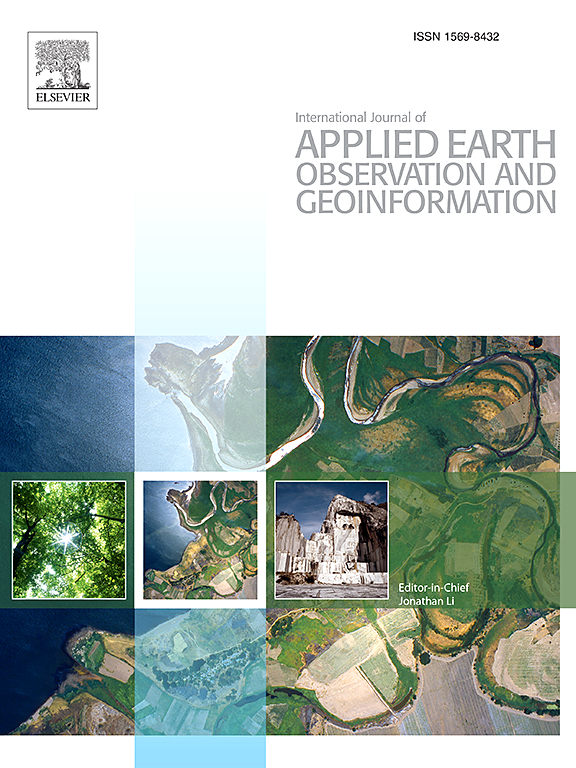青藏高原地表温度反演中地形效应误差分析与减小
IF 8.6
Q1 REMOTE SENSING
International journal of applied earth observation and geoinformation : ITC journal
Pub Date : 2025-06-05
DOI:10.1016/j.jag.2025.104637
引用次数: 0
摘要
地表温度在表征地面能量平衡和理解气候变化方面具有重要作用。青藏高原地表温度对区域气候和环境动态具有重要影响。青藏高原准确的地表温度数据对生态监测和气候研究至关重要。然而,大多数检索算法都假设了平面热红外辐射传递方程(TIRTE),这在TP复杂的地形中引入了不可避免的地形诱导。此外,有限和稀疏的地面站阻碍了像素级误差分析。这些限制限制了地形对地表温度误差影响的准确表征,阻碍了当前地表温度数据集的有效应用。本文提出了一种在像元水平上量化地表温度反演误差的方法,并创新性地引入了辐射地形偏差校正项(RTBC)。从理论上证明了RTBC在减少单大气参数反演LST误差方面的有效性。随机森林(RF)模型用于评估地形效应对这些误差的贡献。采用天空视野因子(SVF)作为地表粗糙度的指标。结果表明,地表粗糙度较大(SVF≤0.25)时,地表温度反演误差主要受地形效应影响,R2值高达0.86;在SVF≤0.25时,RTBC是影响LST检索误差的主要因素。原位LST分析表明,当SVF降至0.738时,RTBC有效降低了均方根误差(RMSE)和平均绝对误差(MAE),平均分别降低了1.2 K和1.1 K。在与传统方法的比较实验中,RTBC实现了RMSE约50%的降低。这些发现强调了地形对地表温度检索精度的显著影响,并证明了RTBC在减少地形误差方面的有效性。本文章由计算机程序翻译,如有差异,请以英文原文为准。
Analysis and reduction of topographic effect induced errors in land surface temperature retrieval over the Tibetan Plateau
Land Surface Temperature (LST) plays a pivotal role in representing ground energy balance and understanding climate change. LST over the Tibetan Plateau (TP) significantly influences regional climate and environmental dynamics. Accurate LST data in the TP is vital for ecological monitoring and climate studies. However, most retrieval algorithms assume a flat-surface thermal infrared radiation transfer equation (TIRTE), which introduces inevitable topographic induced in the TP’s complex terrain. Additionally, the limited and sparse ground stations hinder pixel-level error analysis. These limitations restrict accurate characterization of topographic effects on LST errors and impede the effective application of current LST datasets. This study proposed a method to quantify the LST retrieval errors at a pixel level and innovatively introduced the radiation-topographic bias correction term (RTBC). The effectiveness of RTBC in reducing LST retrieval errors with only one atmospheric parameter was demonstrated theoretically. Random forest (RF) models were employed to assess the contribution of topographic effects to these errors. The sky view factor (SVF) was employed as an indicator of surface ruggedness. The results demonstrated that LST retrieval errors were predominantly due to topographic effect when surface ruggedness was high (SVF ≤ 0.25), with an R2 value reaching up to 0.86. RTBC emerged as the primary factor influencing LST retrieval errors at SVF ≤ 0.25. In-situ LST analysis showed that when SVF decreased to 0.738, RTBC effectively reduced the root mean square error (RMSE) and the mean absolute error (MAE) and by an average of 1.2 K and 1.1 K, respectively. In comparison experiments with conventional methods, RTBC achieved approximately a 50 % reduction in RMSE. These findings highlight the significant impact of topography on LST retrieval accuracy and demonstrate the effectiveness of RTBC in reducing terrain-induced errors.
求助全文
通过发布文献求助,成功后即可免费获取论文全文。
去求助
来源期刊

International journal of applied earth observation and geoinformation : ITC journal
Global and Planetary Change, Management, Monitoring, Policy and Law, Earth-Surface Processes, Computers in Earth Sciences
CiteScore
12.00
自引率
0.00%
发文量
0
审稿时长
77 days
期刊介绍:
The International Journal of Applied Earth Observation and Geoinformation publishes original papers that utilize earth observation data for natural resource and environmental inventory and management. These data primarily originate from remote sensing platforms, including satellites and aircraft, supplemented by surface and subsurface measurements. Addressing natural resources such as forests, agricultural land, soils, and water, as well as environmental concerns like biodiversity, land degradation, and hazards, the journal explores conceptual and data-driven approaches. It covers geoinformation themes like capturing, databasing, visualization, interpretation, data quality, and spatial uncertainty.
 求助内容:
求助内容: 应助结果提醒方式:
应助结果提醒方式:


